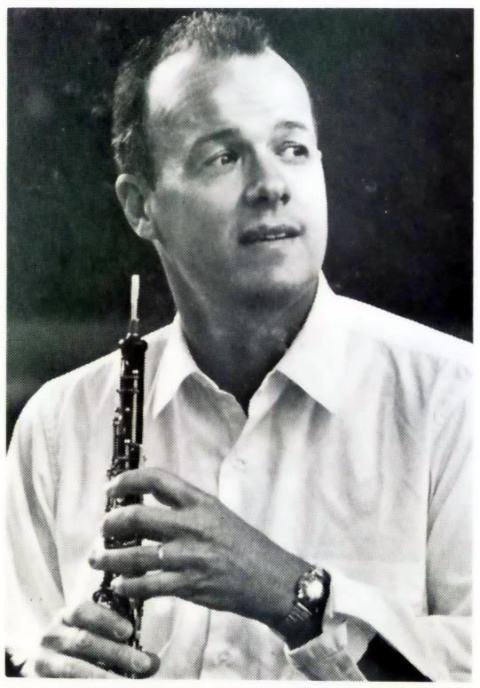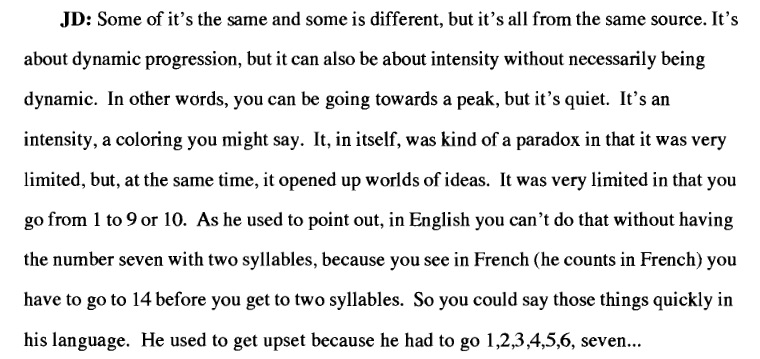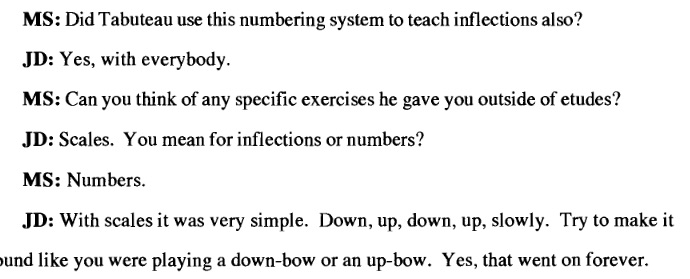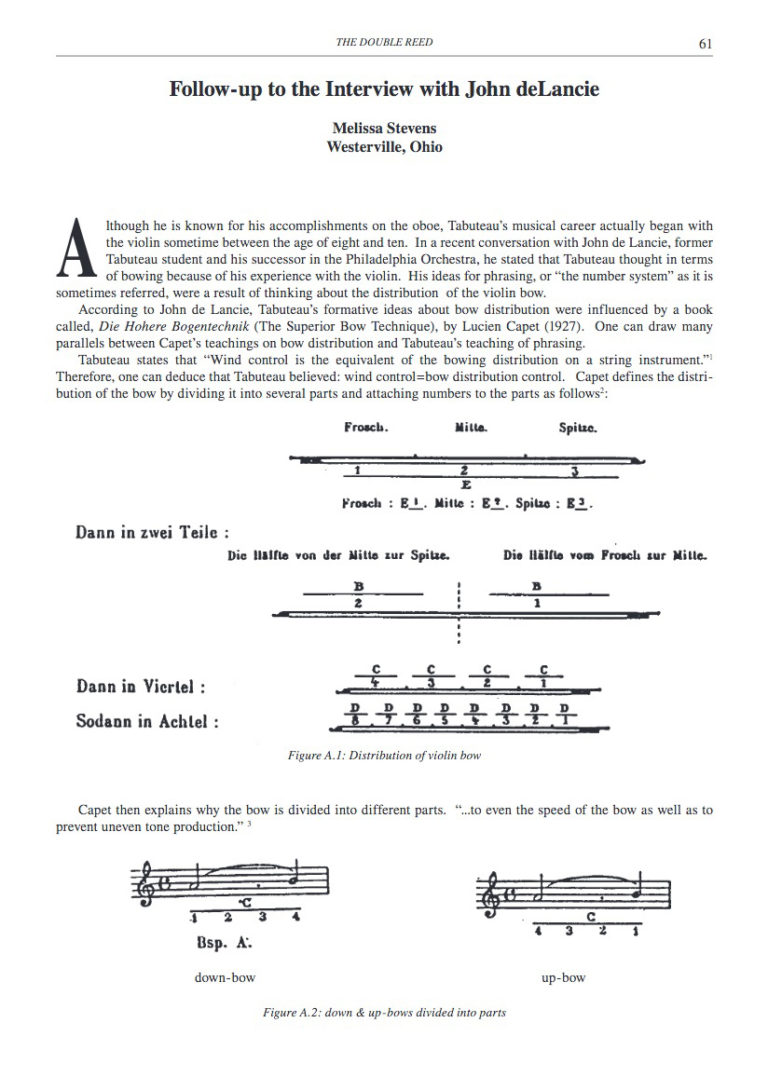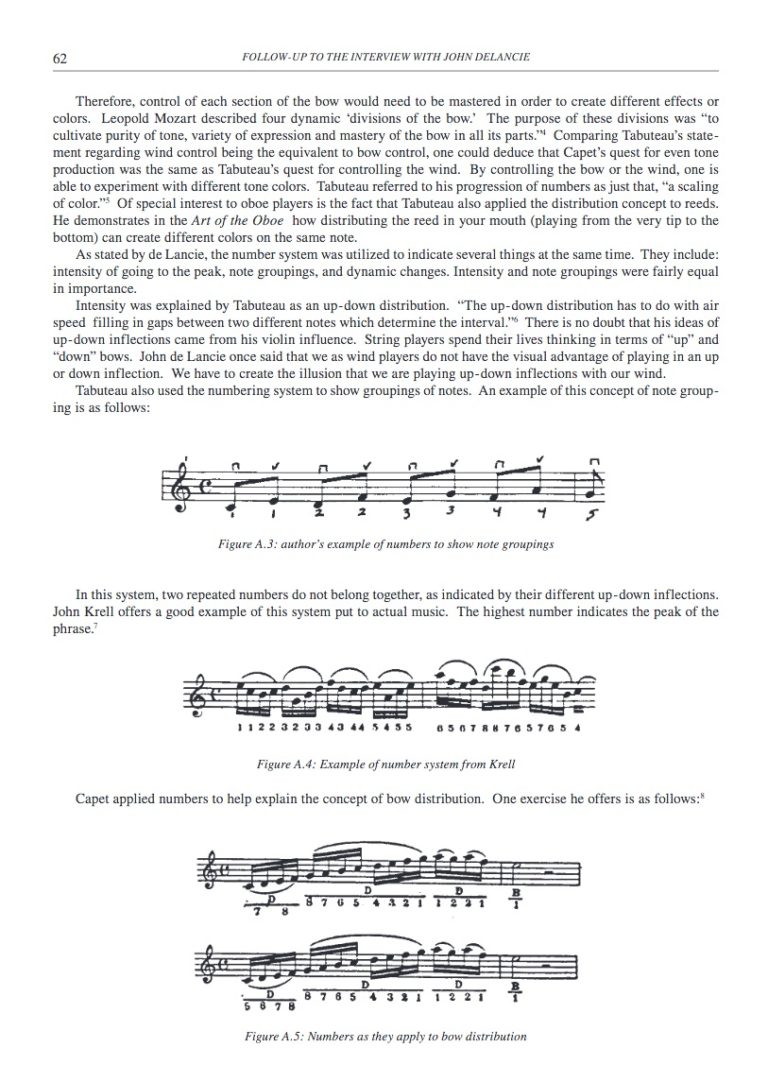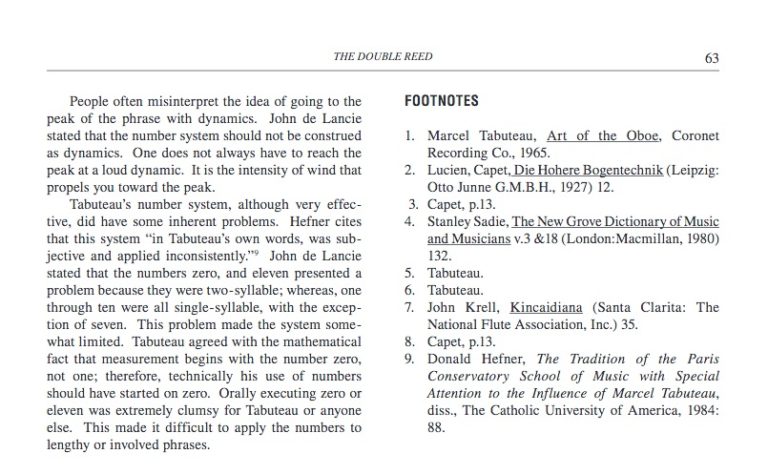John de Lancie (1921–2002) studied with Marcel Tabuteau at the Curtis Institute of Music from 1936 to 1940, succeeding him in 1954 as principal oboe in the Philadelphia Orchestra and at Curtis. He became Director of the Curtis Institute Music in 1977 serving for eight years. He commissioned two works for oboe: the Benjamin Lees Oboe Concerto and ‘The Flower Clock’ by Jean Francaix. In interviews with Laurie Van Brunt, Donald Hefner, and Melissa Stevens, de Lancie reported the following in regards to the Tabuteau System.
The following excerpt is from Laurie Van Brunt’s 1977 interview of John de Lancie concerning the Tabuteau System:
LVB: What was your understanding of his numbers system?
JD: Well, his number system, my understanding of his number system was that it was, I would say three, what’s the word?, it had three meanings. It was in the most a…., well I won’t try to put them in what was the most important, I would say it had to with the grammatical structure of music in explaining the groupings of the notes, so that the concept of phrasing was not left to chance. The second thing was that it had, it also dealt with dynamics, and it also dealt with intensity. I want to make clear that those two things were not the same in any way to him. In other words, intensity could increase maybe with dynamics decreasing, just because loud and soft was not the only part of intensity. So, I would say those were the three things that the number…
LVB: What did intensity consist of?
JD: Well, intensity you know, some… Music in general, I mean, in a very of sort of basic few words, phrases start from a point of minimum tension to a point of maximum tension and then back to a point of minimum tension. I am speaking about the harmonic progressions, and the melodic line follows the harmonic progressions. That’s what I’m speaking about in intensity.
LVB: How does vibrato fit in with this?
JD: Well, vibrato was something, which was a very personal thing, which he never taught. He, at least in my case, the couple of times that I got up enough nerve to ask him something (because most of us were always afraid to even ask questions) he just said, “Well, don’t worry about it, it will take care of itself.” In my case, I feel fortunate in that it did take care of itself. He said, ”Just keep on playing long tones, and it will happen,” and sure enough it did happen. But, I have found in my thirty years of teaching that it doesn’t always work out that way with some students, and I would say that there are some of his students that could be pointed out as examples of where it didn’t work also. He never made, very rarely ever made a reference to it, except that he didn’t like a lot of it. Anybody who would try to use a great deal of it, he would say, “Forget it.”
LVB: In your understanding of the number system was an increase in the speed of vibrato part of an increase in intensity?
JD: Well, yes, but that, increase in the speed of the vibrato, well you’re, I mean he never, he never tried to talk of this intensity in terms of vibrato. He talked about intensity in terms of the speed of the wind. The idea that somewhat parallel to the speed of the bow on a string. You can go fast or you can go slowly and so on and so forth and that was to a degree. Vibrato was never referred to as being a tool or part of the equipment, at least as far as I can tell you. It was kind of left to being kind of an individual thing.
LVB: Did he talk about it in the chamber music classes at all?
JD: No, never. I must say to you that when I am talking about what he said, there was no difference between the way he talked in chamber music classes or orchestra classes and private lessons, it was always the same. Obviously in private lessons there were things which referred, you know, involved the instrument or reeds; otherwise it was always the same.
LVB: Were changes in color part of the number system?
JD: Yes, yes very definitely. But that again is, you know one of his ideas that he had evolved something that no one else had ever done and that is: he could take as he used to say a “jackass” and make him play well, because he analyzed things, and he would tell somebody with the number system to explain to them how they were supposed to play a certain phrase. He could take somebody who didn’t have any great natural response to music, and he could get them to play something which would sound very good. And this was true, because he demonstrated it on many, many occasions. The only hitch in that was that the ones he considered untalented, that he would end up making them play well, they played well as long as he was the one who showed them how to play. But, it was sort of like a puppet, as long as somebody was pulling the strings they managed to do pretty well, but as soon as they went off on their own [laugh], they were just as bad off as they were before.
LVB: How great was Tabuteau’s variations in color in his playing?
JD: Well, [laugh] how great? They were greater than anything I have ever heard before or since, put it that way; I don’t know how else to express it. He had an enormous, enormousfacility and a range on the instrument, an enormous range of color and dynamics, and he had the type of embouchure that allowed him to play the kind of a reed that gave him more of that than anyone else I’ve ever heard.
LVB: What was the difference between the numbers and the concept of up and down impulses?
JD: Well, the numbers as I said were involved in the, to a great degree in explaining the grammatical structure of the musical phrases that we were working with. Up and down was something which went along with this. The simple thing of up and down is basically in music most of us react to the sounds that we hear. If somebody sits down and plays a dominant seventh chord, you anticipate that they are going to resolve it, right? That’s the reaction this has; okay. The very basic thing was that up is five (V) and down is one (I). Now this is also closely associated in music with the metric structure in that generally five (V) will come on the fourth beat of a 4/4 bar and one (I) will come on the first beat or could be obviously on the second or third beat, but generally it falls on the strong beat. The strong beat is the one (I) and the weak beat is the five (V). So that is a very primitive explanation of up-down. Now, if you listen to any phrase, musical phrase, you’ll find that the impulse of up can be harmonically construed for a number of successive notes. It may be that in a 4/4 measure the second, third, and fourth beats of the measure can all be part of the preparation for the cadence that’s going to occur on the downbeat of the next measure. So, that was what he was trying to impart to us, the feeling of it. And he also had had some training when he was a very young boy as a violinist; he started out by playing the violin for a couple of years of his life before he switched to the oboe, and ever since that time, he was very much inclined to demonstrate in all of his classes as though he was playing a violin; everything was done with the bow. He would say to us, “No, don’t you hear that, it’s up up down.” And he would say up up down, he would make that gesture as though he were playing a violin, up up down. And it could be up up up up up up down. Obviously there are practically limitless the different kind of combinations that can be formed with that, just depending on what the composer intended. So that this was an aspect that he could use when he spoke, in other words articulate in the words that he used, but he could also be visual in that he showed us what he was doing. And you can’t separate one from the other; it was all tied in, you know, the whole thing…
You know I started to tell you or I did say a few minutes ago that he felt all these things had to be, that he could define these things, and it’s true, in my entire life, I have never heard anybody that was able to explain music in such a way and that would totally defythe idea that when music was explained that it became a heartless, bloodless situation. On the contrary, it seemed to become even more inspired and have more of this feeling of spontaneity. But, nevertheless you can’t explain everything, you see. If you could put everything into words, you wouldn’t have to have the music. You could just have poetry… or prose. If art forms, at least this is my idea, I don’t know if this would be upheld by some of the great teachers in the world, but my idea is that art forms have evolved through man’s need to express something in an area that he couldn’t find any other way to express it. It just doesn’t fit in any other area. For him it’s got to be a poem, and for somebody else it had to be a sonata, and for somebody else it had to be an opera, and for somebody else it had to be a painting and so on and so on. And these things just didn’t happen overnight; they were the result of thousands of years of evolving. So he explained to a point, way beyond anybody else’s ability to do it, because I have subsequently spent my lifetime playing in orchestras and hearing men explain things, and I can only say that no one even approached his ability to explain. I mean even Stokowski, who used to be able to
conjure up magnificent pictures and one thing and another, but with Tabuteau he made it so that, as he said, a fool could eventually take a phrase and make it sound quite beautiful. Now the question was that, if you had talent, you could learn, you understood, and then you began to figure it out for yourself and then be able to apply to other situations. If you didn’t, you could do it on that one particular example after he had shown you how to do it. So this is where this other element of talent comes in, ability or musicality, there are all kinds of words, everybody has their own preference.
LVB: Just one more thing about the up and down, he [Tabuteau], makes the analogy between inhale and exhale.
JD: Yes, well, okay, inhale-exhale, up bow-down bow, weak-strong; it’s there, it’s all the same.
LVB: I meant to ask, do you use numbers and these principles of up and down in your teaching?
JD: Oh yes, sure, I’m his pupil. [laugh]
LVB: Were there also principles of articulation?
JD: Oh yes, very definitely.
LVB: Why did he explain articulation in terms of taa, tee and long?
JD: Well you know, how else would you articulate? You had to attack, so it was taa – taa taa taa taa taa taa. I don’t think there was any specific difference between taa and tee. The idea of articulation was that it was to be a line; it was not to be separated.
LVB: Did he use any tonguing variations according to style period?
JD: No. In general his articulation was the same; it was the most beautiful articulation I’ve ever heard in that it was astonishingly elegant; it was just exquisite; it was the refinement. It was like listening to [John] Gielgud talk. The speech was just beautiful. If you listen to, nowadays we have the opportunity to hear Masterpiece Theater all these English productions, if you hear some of these people who are obviously brilliant and who have just beautiful articulation, that’s the way it was. He didn’t vary this very much. In other words he, it was only under duress that he would use articulations that were contrary to his ideas even though there are lots of people who say you have to use different kinds of articulation according to different types of music, this was not the case with him. And I’m not so sure that he was wrong. I think that there are perhaps times when yes it could be, but in general the point being that a great deal is made of how articulation should be done in this piece or that piece or so on and so forth and according to this period or that period. When the actual truth of the matter is that nobody knows say before 1900 how anyone sounded or played. [laugh] It’s all conjecture, and in most instances the conjecture usually is the way the person who’s telling you is usually telling you the way he played. That’s the way it should be. They’ll tell you that this is straight out of the eighteenth century, but if you go a little bit further, it’s just because that’s the way they played. The theories are made to accommodate the player.
LVB: And this would be the same with the slur? He always played the last note of the slur long?
JD: To a degree, it would depend, ya. You see again these things which are, it’s hard for me to discuss it on a general level, you would have to have specific examples to discuss it. In general, I would say, yes, he was the one who pointed out that if you have a group of four notes, three slurred and one staccato and then going on to the next one, the third note wouldn’t have to be short just because you’re
going to articulate the fourth note. But as I just said that a lot people do that because that’s the only way they can play. They don’t know how to articulate any other way. It’s just the same as making a smooth connection in articulated passages on the piano as their thumb, as they are playing up a scale and as they are going and they’re going from one thing to another, it’s hard to do that. So a lot of these players adapted their theories according to what they could do. So, da dut da dut da dut on two and two and two, because it was hard to go: da da da da; it was hard to make an even scale. And the whole thing just doesn’t stand up, the idea that the second note should be short. If you could harmonically state that every first note was an appoggiatura and the second note was the resolution of the appoggiatura and then you start, but it doesn’t work that way. I mean they’re passing tones or whatever chordal and one thing and another, they don’t all turn out that way, so they have to keep on going.
LVB: How restrictive was the bar line?
JD: How restrictive?
LVB: Yes.
JD: Well, it was axiomatic that you did not breathe on a bar line. Now some of us carried that to the extreme in the early days. I know that I did; it was a while before, I mean we all approached this…, if he would say climb up on top of a building and jump off, why most of us would do it. So, if he said don’t breathe on the bar line, we just assumed that that meant never, without any exceptions. [laugh] But as time went on and we developed our own musical insight, we realized that this is not the case. There are times when you can breathe on the bar line. But, if you had to make a rule of thumb, it’s a very, obvious one. In other words, out of one hundred times I would say that ninety-five times you should not breathe on the bar line. There might be five per cent exceptions. But, you have to learn to be able to recognize those exceptions.
LVB: There are a few things about breathing that I didn’t ask about. Did you ever hear Tabuteau say something like it is important to remember to place one’s notes on the wind or the bow and not to bow or wind the notes?
JD: Oh sure, oh sure. But that has nothing to do with breathing. I mean, what do you mean breathing, where to take a breath?
LVB: No, not where to take a breath, just, maybe that doesn’t have to do with breathing.
JD: Well, that’s very simple, you make a line with your wind, and you put your notes on that line; you don’t make a line with the notes. This is to achieve a continuity in a phrase.
LVB: Did he differentiate between wind pressure and wind speed?
JD: Well, no. I think… you know you would have to be specific.
LVB: Did he talk about breathing, I mean not where to take a breath necessarily…
JD: Well, he talked about where to take a breath all the time.
LVB: With numbers and the grouping?
JD: Well sure, even without the numbers, I mean there are places that are obviously good and places that are obviously bad.
LVB: Did he talk about breathing as something, you know, how to take a breath and how to support and that kind of thing?
JD: No, his approach was that you just take a breath, and you blow through the oboe and if you do all of these…, now of course, one of the big parts of the lesson was just playing long tones and these different exercises – ninths and playing from low c up to high c in all sorts of… [end of side of tape]
The following is an extract from Donald Hefner’s 1984 dissertation: The Tradition of the Paris Conseratoire School of Oboe Playing with Special Attention to the Influence of Marcel Tabuteau:
When the Curtis Institute was founded in 1924, Marcel Tabuteau was engaged to teach oboe, woodwind ensemble, orchestral winds, percussion class, and string classes. As John de Lancie has remarked, “It was during this time that his concepts were crystallized and his brilliant ability to communicate with the young musicians of that period captivated and radically transformed the musical lives of all those who came under his influence.”
In class structure and curriculum, the Institute resembled the Conservatoire; the resemblance was obviously intentional. No classes were given before noon so that the morning hours could be devoted entirely to practice. Orthodox (“fixed do”) solfege, taught by a French instructor, was required throughout the years of study unless one could pass an immensely difficult “standard” solfege examination. Harmony, counterpoint, form and analysis were required as well as the all-important ensemble and orchestra classes.
John de Lancie made the observation that undertrained players manifest their deficiencies most clearly “in the area of pianissimo.” It was to this area that Tabuteau addressed so much of his training in the form of “drives”, of scales, and of the level of control demanded in his now legendary ensemble classes. As he said in 1965, “In my opinion, the quality that carries is the amplification of a dolce tone. The dolce tone is the nearest to zero!”
The “drives” began each lesson. They consisted of patterns of articulated (or sometimes unarticulated) notes of increasing, then decreasing, intensity. They addressed at once so many of the problems of “tone emission” that are at the core of the difficulty of oboe playing: wind control, articulation, reed placement, tone coloring, and even phrasing. They were very difficult to do.

